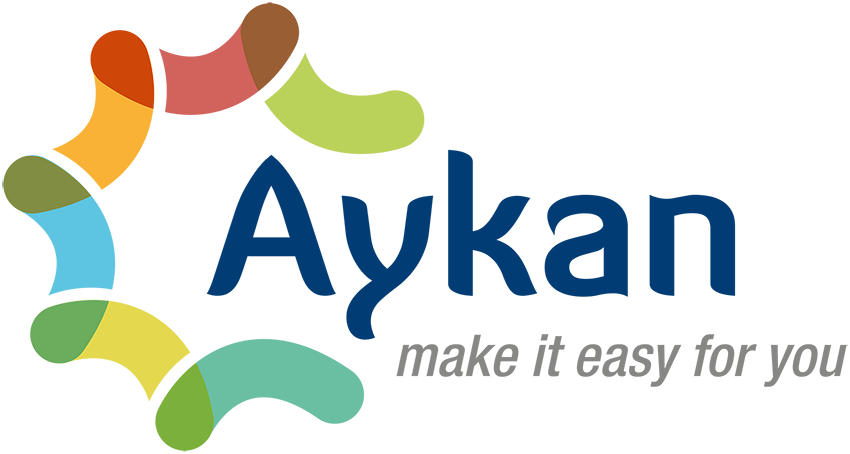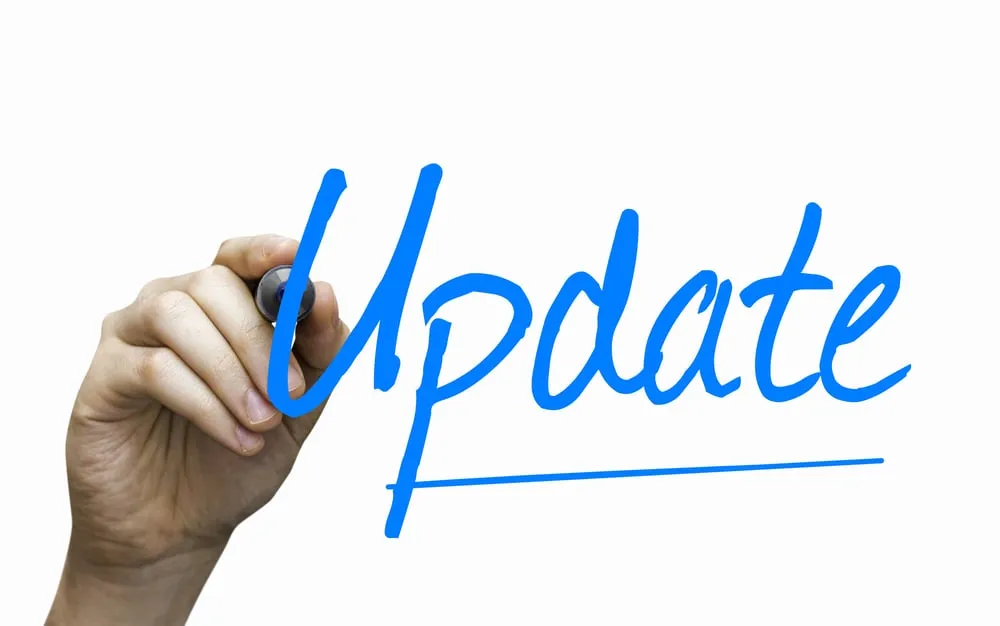Introduction
The latest no-code release from Sharetribe brings significant improvements to how marketplace operators can manage and streamline the user experience. Specifically, it introduces more granular control over user interactions based on user types, allowing you to create more focused and intuitive interfaces for supply and demand roles.
Whether you’re operating a traditional B2C marketplace, a B2B platform, a reverse marketplace model, or even a platform without online payments, these new capabilities can be used to create cleaner, more relevant user journeys. You no longer have to rely on workarounds or complicated permissions logic to hide or show elements that don’t make sense for certain users.
With user roles and user account links, you can fully customize what each type of user can see and do within your marketplace.
Understanding User Roles in Sharetribe
With the new user role settings, Sharetribe allows you to assign each user type one of two specific roles: provider (supply) or customer (demand). You can also assign both roles to a single user type if your marketplace supports dual-function users.
Assigning user roles defines the structure of their experience within the platform. For example, providers will access a provider inbox and receive reviews from customers, while customers will access their own customer inbox and see reviews they have given to providers. This creates a distinct and streamlined interface that eliminates confusion and clarifies the user’s position in any transaction.
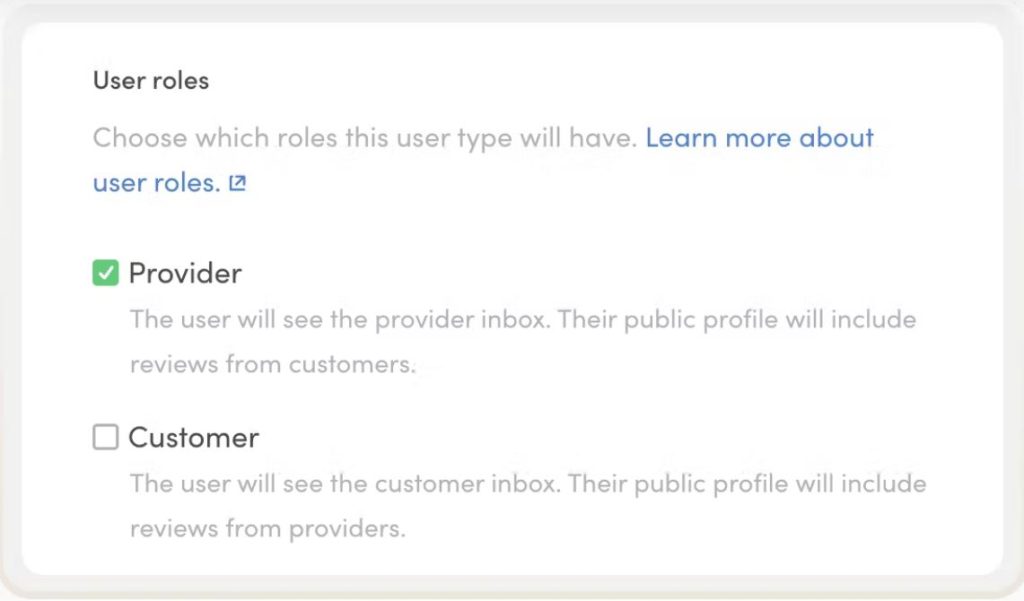
This role-based experience improves not only the UX but also enhances trust and transparency. It makes it easier for providers to track their bookings and communications, while customers can manage their purchases or service engagements more clearly.
If your users perform both roles (e.g., in peer-to-peer marketplaces), enabling both roles allows them to view and manage listings, payments, and reviews from both perspectives. This flexibility ensures that dual-role users aren’t limited by a one-size-fits-all design.
Sharetribe also allows operators to modify the labels for these sections to reflect the marketplace’s tone or branding. Customizing these labels helps deliver a fully branded experience and ensures users are never confused about where to find key actions or messages.
User Account Links: Control Visibility for Key Actions
User account links are action-based navigation items found in the user’s account panel. With this release, Sharetribe gives you the ability to toggle three key account links per user type:
Post and manage listings
Payout details
Payment methods
Controlling these links ensures that only the relevant users see the actions that apply to them. This reduces cognitive load and keeps the interface clean and intuitive.
Post and Manage Listings
You can now determine whether a user type can access the functionality to post or manage listings. This is particularly important in marketplaces where only one side of the user base should be listing content.
For instance, in a B2C or B2B marketplace, only providers should have the ability to post listings. Customers should only be able to browse and book or purchase from listings created by providers.

Conversely, in a reverse marketplace, the customer is the one who posts a listing (e.g., a job requirement or a service request), and providers respond by bidding or applying. In this case, only the customer user type should be able to post listings, and the provider should not have access to those features.
In peer-to-peer marketplaces, where users often play both roles, enabling listing creation for all user types makes sense. Sharetribe’s flexibility allows you to configure the exact flow that suits your platform’s logic.
Additionally, if you want to hide the “Post a listing” option from all users—including anonymous visitors—you can do so via the top bar settings in the Console.
Payout Details
This setting allows you to control whether a user type sees the link to add payout details in their account. This link is necessary for any user who will be receiving payments, which typically includes service providers or product sellers.
If your marketplace involves online payments, providers must have this link visible so they can set up their payout details via Stripe Connect.
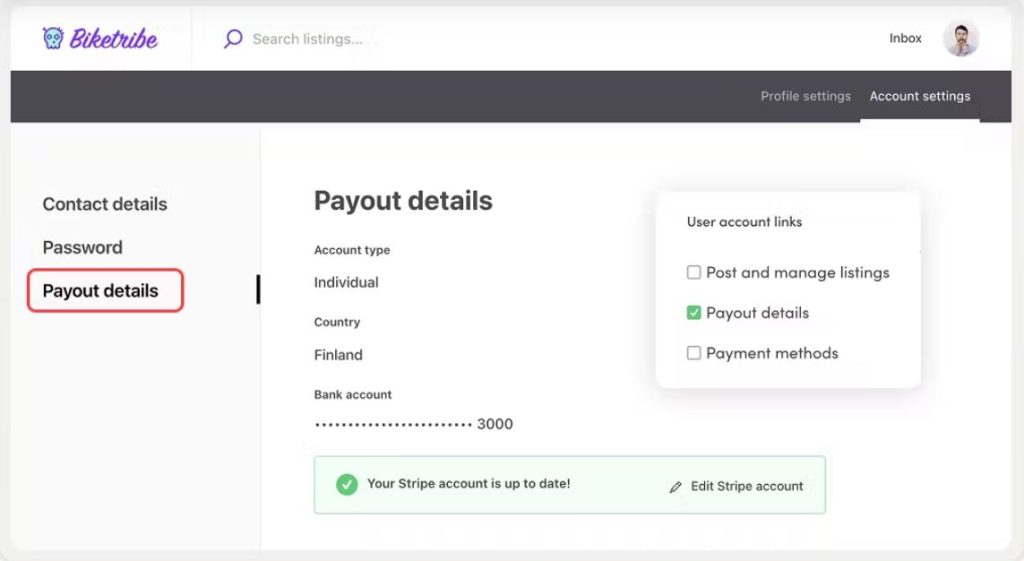
However, if you operate a marketplace without integrated payments, or you handle payments manually or offline, it makes sense to disable this link for all users. Doing so removes unnecessary clutter from the UI and keeps the platform aligned with your actual payment processes.
This kind of fine-tuning reduces user confusion and reinforces the platform’s workflow expectations.
Payment Methods
You can also decide whether a user type should have the option to add a payment method within their account. This is typically relevant only for customer-type users who are making payments on the platform.
In a traditional marketplace where customers book services or buy products, having this link available for them is essential to streamline the checkout process.
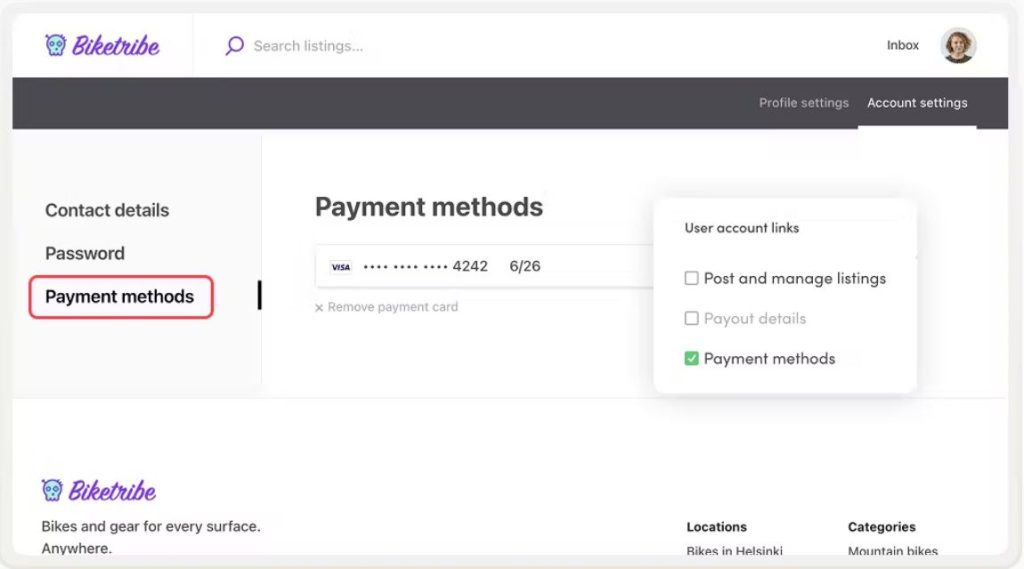
However, in marketplaces where online transactions aren’t used (such as lead-generation platforms, offline-service matching, or consultation platforms where payment occurs outside the app), disabling this feature removes friction and prevents questions about how payments work. As with payout details, hiding this link for users who don’t need it helps guide them toward the actions they should actually take—reducing missteps and improving engagement.
Use Cases That Benefit from These Features
These settings are particularly useful for marketplaces with distinct user roles or non-traditional structures:
In a services marketplace, only providers should post listings, and only customers should add payment methods.
In a job board or freelance bidding marketplace, customers post jobs (listings), while providers respond. Payout links are needed only by providers.
In a consultation marketplace without online payments, both payment method and payout detail links can be disabled for all users.
In a hybrid peer-to-peer rental platform, both user types may need to post listings, see both types of inboxes, and use both payment and payout functionalities.
These examples show how Sharetribe’s update enables you to closely align your UX with your operational model, minimizing friction and confusion.
Conclusion
This release significantly enhances the flexibility and control you have over your marketplace’s user experience—without requiring any code. By enabling distinct roles and customizing visibility for key actions, you ensure that users only interact with what’s relevant to them. This not only improves usability but also builds trust, increases engagement, and reduces support queries.
As marketplaces become more niche and user expectations grow, tools like these help you remain agile and user-focused. Sharetribe continues to empower marketplace operators with no-code and low-code tools that reduce complexity while expanding functionality.
Now’s the perfect time to refine your marketplace user experience. Head over to your Sharetribe Console and start configuring user roles and account links to build a cleaner, more intuitive, and more powerful platform for your community.
